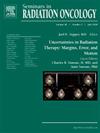Hypofractionation/Ultra-hypofractionation for Prostate Cancer Radiotherapy
IF 3.2
3区 医学
Q3 ONCOLOGY
引用次数: 0
Abstract
Prostate cancer is the most commonly diagnosed cancer in men worldwide. Radiotherapy is an integral component for the treatment of localized prostate cancer. Radiobiologically, prostate cancer is sensitive to an increased dose of radiotherapy delivered per fraction, called “hypofractionation”, due to intrinsic differences in the rate of cancer cell growth and repair of DNA damage. Hypofractionation delivers planned treatment over fewer radiotherapy sessions compared to conventional fractionation and has been shown to be noninferior to conventional fractionation with an acceptable toxicity profile. Ultra-hypofractionation, often delivered via stereotactic body radiotherapy (SBRT), further reduces the number of treatments by using even larger doses per fraction and has shown promising results with high biochemical control rates and low rates of late toxicity. The adoption of hypofractionated and ultra-hypofractionated schedules improves resource utilization in radiation oncology without compromising patient safety or efficacy. Ongoing research continues to refine patient selection, fractionation schemes, and incorporates advanced imaging, precise treatment planning, and motion management techniques to help mitigate toxicity and optimize outcomes in localized intermediate and high-risk disease.
低分割/超低分割在前列腺癌放疗中的应用
前列腺癌是世界范围内最常见的男性癌症。放射治疗是局部前列腺癌治疗的重要组成部分。放射生物学上,由于癌细胞生长和DNA损伤修复速度的内在差异,前列腺癌对每部分放射治疗剂量的增加(称为“低分割”)很敏感。与传统分割相比,低分割提供了更少的放疗疗程的计划治疗,并且已被证明不低于传统分割,具有可接受的毒性特征。通常通过立体定向体放射治疗(SBRT)进行的超低分割,通过使用更大的剂量进一步减少了治疗次数,并显示出高生化控制率和低晚期毒性的良好结果。低分割和超低分割方案的采用提高了放射肿瘤学的资源利用,而不影响患者的安全性或有效性。正在进行的研究继续改进患者选择、分离方案,并结合先进的成像、精确的治疗计划和运动管理技术,以帮助减轻局部中高危疾病的毒性和优化结果。
本文章由计算机程序翻译,如有差异,请以英文原文为准。
求助全文
约1分钟内获得全文
求助全文
来源期刊
CiteScore
5.80
自引率
0.00%
发文量
48
审稿时长
>12 weeks
期刊介绍:
Each issue of Seminars in Radiation Oncology is compiled by a guest editor to address a specific topic in the specialty, presenting definitive information on areas of rapid change and development. A significant number of articles report new scientific information. Topics covered include tumor biology, diagnosis, medical and surgical management of the patient, and new technologies.

 求助内容:
求助内容: 应助结果提醒方式:
应助结果提醒方式:


